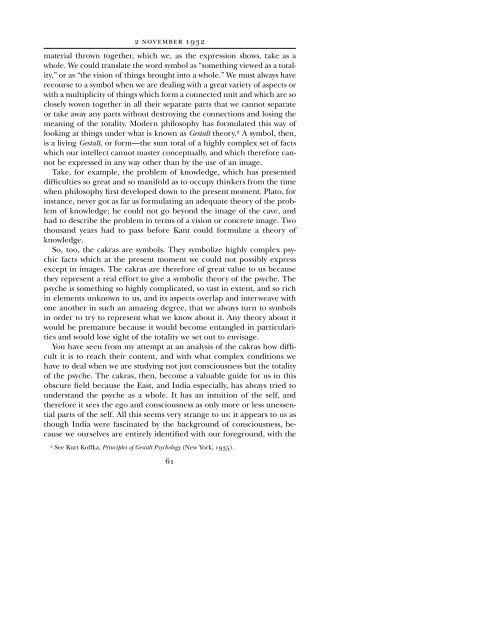CG JUNG - Countryside Anarchist
CG JUNG - Countryside Anarchist
CG JUNG - Countryside Anarchist
Create successful ePaper yourself
Turn your PDF publications into a flip-book with our unique Google optimized e-Paper software.
2 NOVEMBER 1932<br />
material thrown together, which we, as the expression shows, take as a<br />
whole. We could translate the word symbol as “something viewed as a totality,”<br />
or as “the vision of things brought into a whole.” We must always have<br />
recourse to a symbol when we are dealing with a great variety of aspects or<br />
with a multiplicity of things which form a connected unit and which are so<br />
closely woven together in all their separate parts that we cannot separate<br />
or take away any parts without destroying the connections and losing the<br />
meaning of the totality. Modern philosophy has formulated this way of<br />
looking at things under what is known as Gestalt theory. 2 A symbol, then,<br />
is a living Gestalt, or form—the sum total of a highly complex set of facts<br />
which our intellect cannot master conceptually, and which therefore cannot<br />
be expressed in any way other than by the use of an image.<br />
Take, for example, the problem of knowledge, which has presented<br />
difficulties so great and so manifold as to occupy thinkers from the time<br />
when philosophy first developed down to the present moment. Plato, for<br />
instance, never got as far as formulating an adequate theory of the problem<br />
of knowledge; he could not go beyond the image of the cave, and<br />
had to describe the problem in terms of a vision or concrete image. Two<br />
thousand years had to pass before Kant could formulate a theory of<br />
knowledge.<br />
So, too, the cakras are symbols. They symbolize highly complex psychic<br />
facts which at the present moment we could not possibly express<br />
except in images. The cakras are therefore of great value to us because<br />
they represent a real effort to give a symbolic theory of the psyche. The<br />
psyche is something so highly complicated, so vast in extent, and so rich<br />
in elements unknown to us, and its aspects overlap and interweave with<br />
one another in such an amazing degree, that we always turn to symbols<br />
in order to try to represent what we know about it. Any theory about it<br />
would be premature because it would become entangled in particularities<br />
and would lose sight of the totality we set out to envisage.<br />
You have seen from my attempt at an analysis of the cakras how difficult<br />
it is to reach their content, and with what complex conditions we<br />
have to deal when we are studying not just consciousness but the totality<br />
of the psyche. The cakras, then, become a valuable guide for us in this<br />
obscure field because the East, and India especially, has always tried to<br />
understand the psyche as a whole. It has an intuition of the self, and<br />
therefore it sees the ego and consciousness as only more or less unessential<br />
parts of the self. All this seems very strange to us: it appears to us as<br />
though India were fascinated by the background of consciousness, because<br />
we ourselves are entirely identified with our foreground, with the<br />
2 See Kurt Koffka, Principles of Gestalt Psychology (New York, 1935).<br />
61


